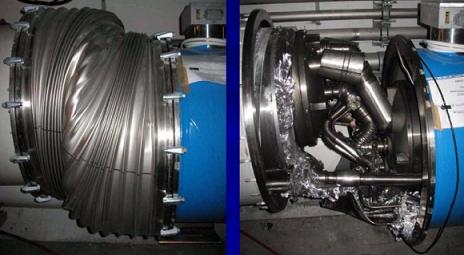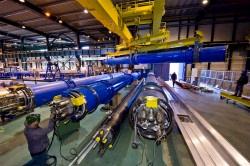|
First
Images Emerge of Damage to the LHC, Replacements Arrive
Written by Ian
O'Neill

A series of problems forced LHC shutdown (CERN/LHC)
On September 19th, CERN
announced that
the Large Hadron Collider had suffered a major incident, known
as a "quench". An electrical short between two of the
superconducting magnets had kick-started a helium coolant leak
inside the tunnels housing the accelerator ring. The quench
caused the magnets to rapidly heat up, severely damaging them.
The violent release of coolant ripped equipment from their
concrete anchors, ensuring a huge repair operation would need to
be carried out. However, it was a while before engineers were
able to access the damage and the news wasn't good: The LHC
would be out
of commission until the spring of 2009 at
the earliest. That was such a sad day.

The first replacement magnet for sector 3-4 arrived

Obvious damage to concrete, where a magnet has been lifted off
its mount (the red boxes) that secured it to the floor (CERN)
Within the first second, an electrical
arc developed and punctured the helium enclosure, leading to
release of helium into the insulation vacuum of the
cryostat. The spring-loaded relief discs on the vacuum
enclosure opened when the pressure exceeded atmospheric,
thus relieving the helium to the tunnel. They were however
unable to contain the pressure rise below the nominal 0.15
MPa absolute in the vacuum enclosures of subsector 23-25,
thus resulting in large pressure forces acting on the vacuum
barriers separating neighboring subsectors, which most
probably damaged them. These forces displaced dipoles in the
subsectors affected from their cold internal supports, and
knocked the Short Straight Section cryostats housing the
quadrupoles and vacuum barriers from their external support
jacks at positions Q23, Q27 and Q31, in some locations
breaking their anchors in the concrete floor of the tunnel.
The displacement of the Short Straight Section cryostats
also damaged the “jumper” connections to the cryogenic
distribution line, but without rupture of the transverse
vacuum barriers equipping these jumper connections, so that
the insulation vacuum in the cryogenic line not degrade.
–Robert Aymar, Status
of CERN Activities,
page 15.
It looks like the
September 19th quench between Sectors 3-4 of the LHC ring is now
being referred to as the "S34
Incident". And
what an incident it was. Fortunately nobody was injured during
the quench, but the LHC wasn't so lucky. For a rundown of the
official account of the S34 Incident, I'll hand over to Robert
Aymar's November 28th presentation (page 15):
The first image (pictured above) clearly shows the extent of the
concrete damage that occurred during the huge pressure forces
generated by the leaking helium, ripping the electromagnets off
their supports (the red boxes in the photo) and shattering the
floor.

Obvious buckling of the accelerator magnets (CERN)
In this second image, the extent of the damage is pretty clear.
Assuming the accelerator beam-line used to be straight
(unfortunately, there is no "before" picture), the violent
displacement of a huge magnet (weighing several tonnes) is
obvious.
Later in the presentation,
Aymar points out that 5 quadrupole and 24 dipole magnets need to
be repaired and around 57 magnets have to be removed to be
cleaned. This will be a huge task, one that will last many
months. According to one eagle-eyed blogger at High
Energy PhDs, a
previous report presented a few days before the Aymar report
signalled that there may be no high energy particle collisions
until 2010. Jorg
Winnenger outlined two possibilities for
the LHC: 1) Partial operations in 2009, allowing only low-energy
particle acceleration to await full-scale repairs through the
2009-10 winter shutdown, or 2) Forget 2009 operations and work
toward full-scale experiments in 2010. Aymar's more recent
report did not mention these scenarios, simply stating, "the
LHC will restart operation in the next spring."

Early progress: replacement parts were inspected at CERN over
the weekend (CERN)
Judging by the mixed signals, we'll have to wait patiently until
it is clear as to when the LHC is expected to recover. Either
way, it will be a long, painstaking and expensive task that
needs to be completed as soon as possible. I
really hope we don't have to wait until 2010 until restart.
Good luck to all involved in the LHC repairs.
US/LHC
Blog, CERN
Photos, Stephanie
Majewski, High
Energy PhDs
Source: http://www.universetoday.com/2008/12/05/first-images-emerge-of-damage-to-the-lhc/
1 2 3 4 5 6 7 8 9 10 Newest
articles
|
